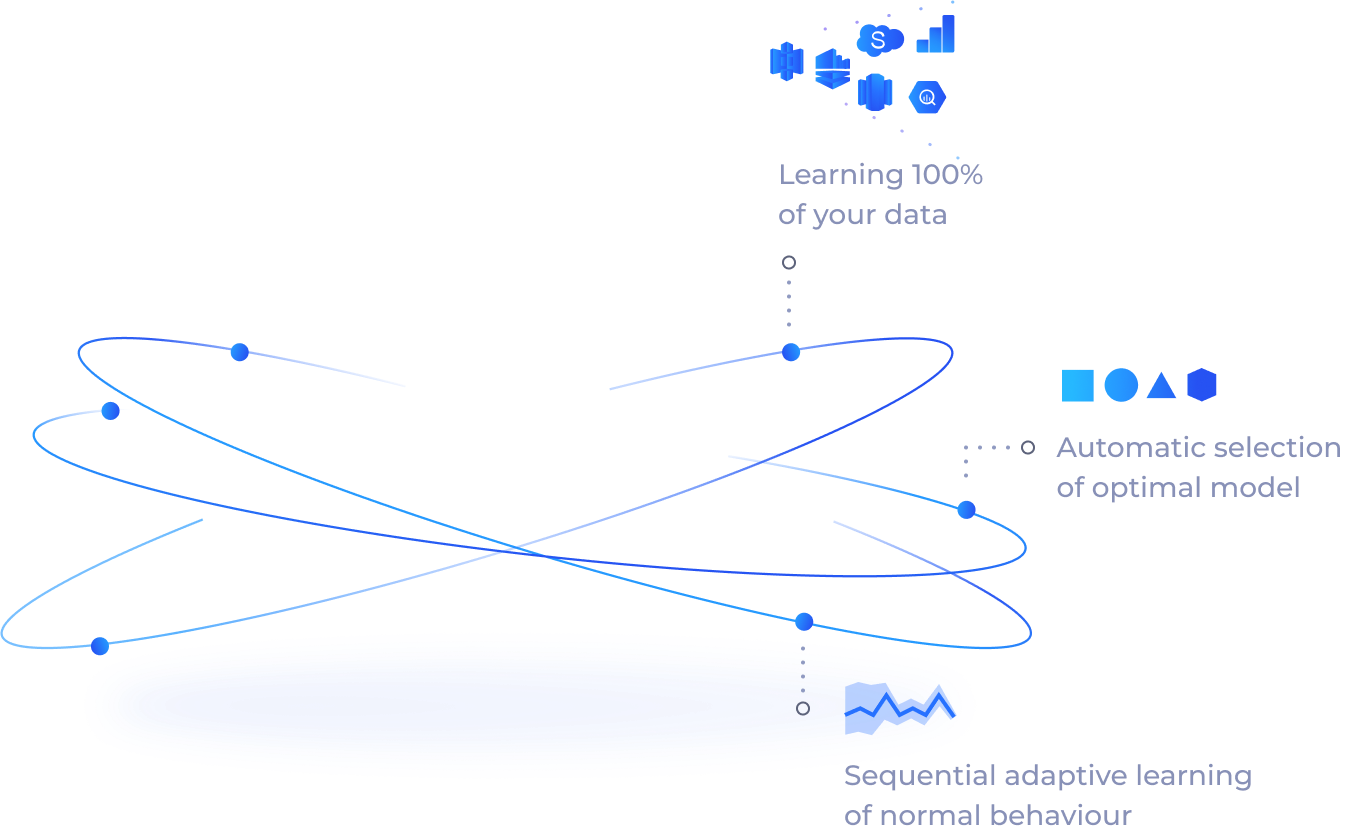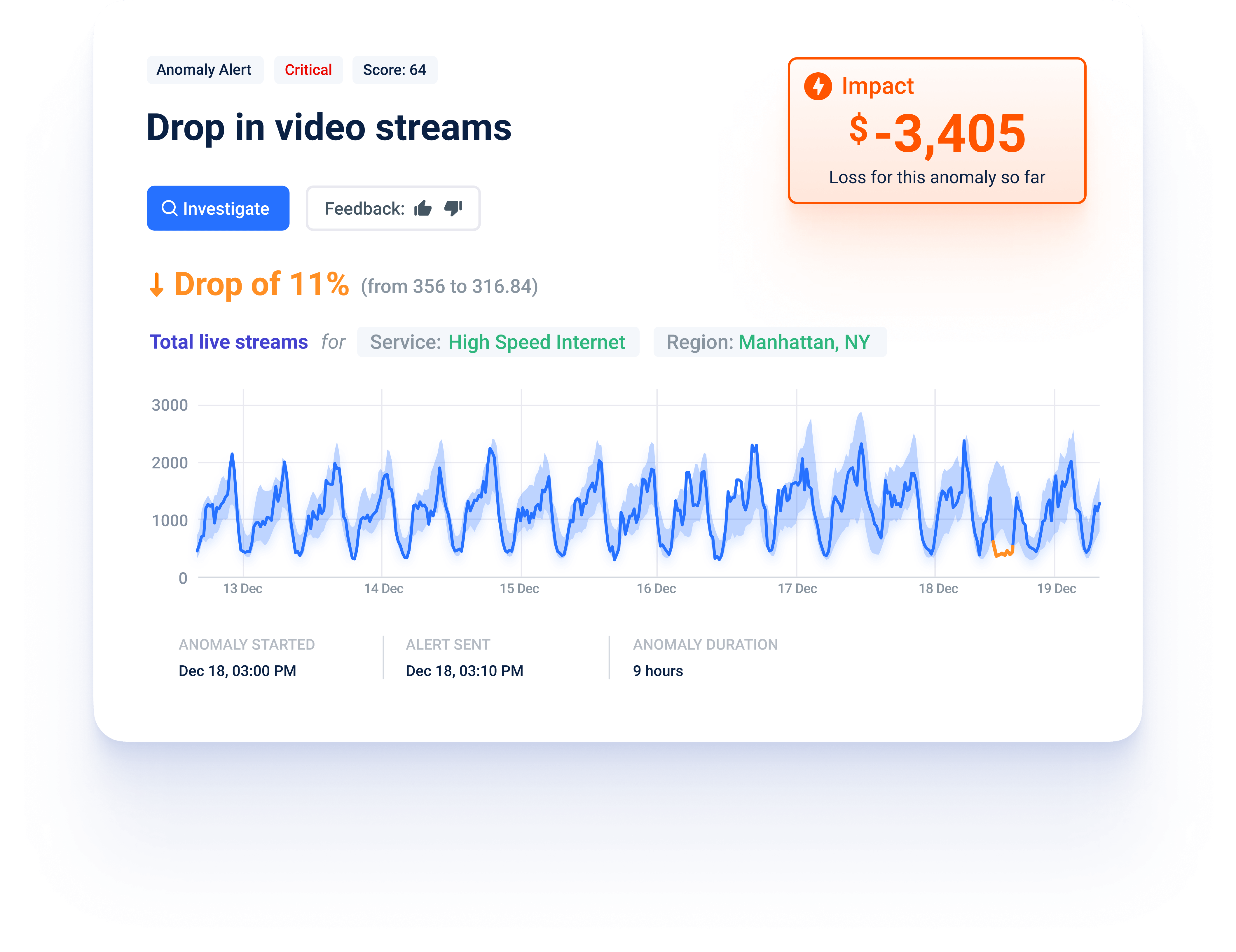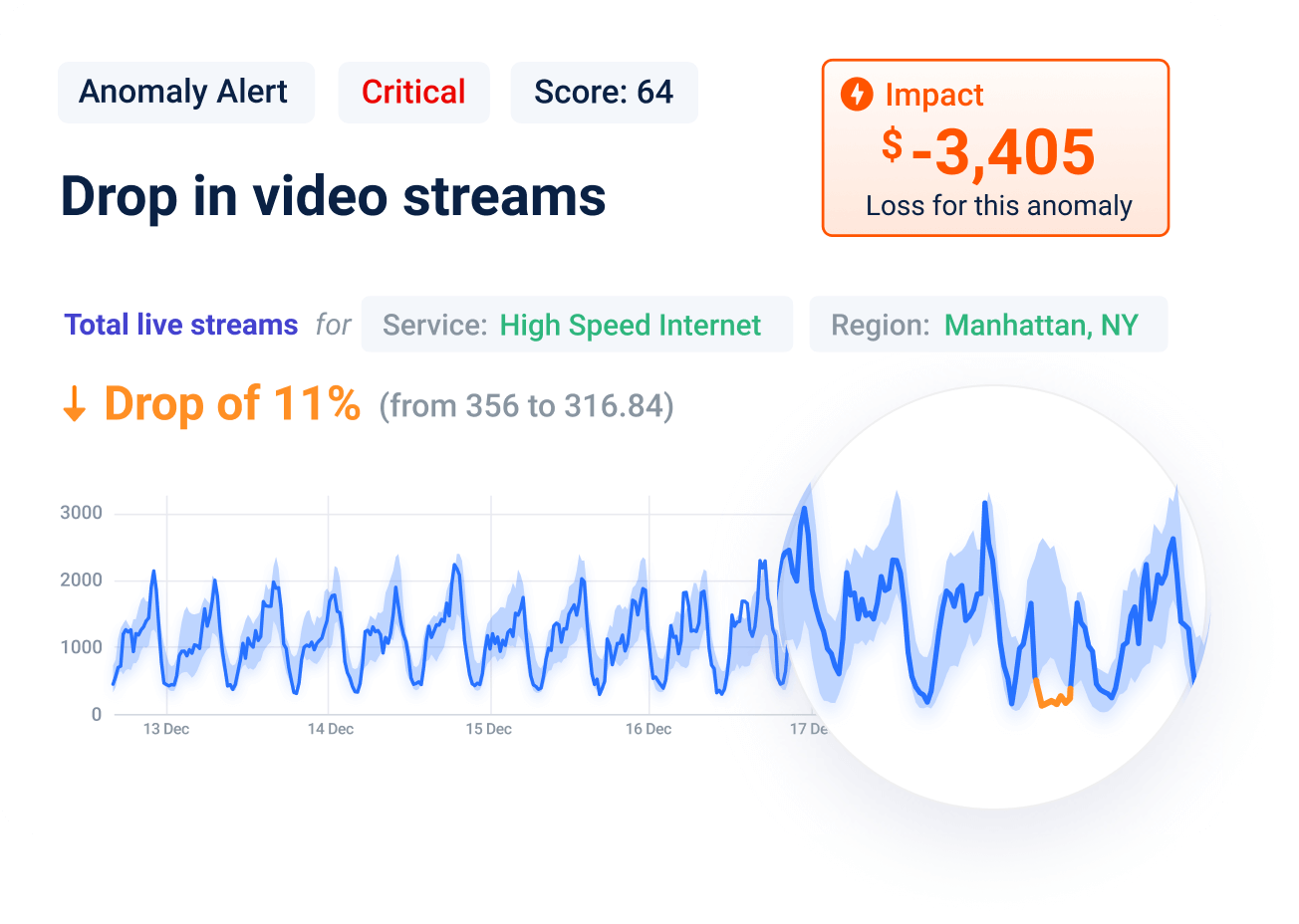Anodot vs. Splunk
Detect and resolve incidents before they impact your customers and revenue with Anodot’s autonomous real-time monitoring of 100% of your data
Download Comparison
Why choose Anodot over Splunk?


Monitors 100% of your data
Not all revenue impactful issues can be observed through IT and application metrics. Very often, cost, customer experience and partners issues occur without leaving a trace in the app or infrastructure data. Why only monitor IT infrastructure and apps—when you can monitor your entire business? Monitoring and correlating 100% of your data and metrics is the only way to spot these common types of revenue bleeds. Anodot scales to billions of metrics, with no restrictions to data or hardware.

Anodot is completely autonomous
With Anodot, there’s no need to manually create a monitor or set alert conditions or thresholds: all metrics and dimensions are monitored all the time with the most appropriate alert conditions and algorithms. Anodot automatically selects the most appropriate algorithm for every metric, adapts to changes in metric behavior, and can switch algorithms in case patterns change. There are no limitations on metrics with strong trends and recurring patterns: Anodot’s robust algorithm library is built to autonomously baseline and monitor any type of signal.





Fastest incident detection and correlation
Anodot’s patented correlation engine, that works across all data sources, metrics and dimensions, creates a complete picture of every incident, including root cause analysis, for lightning-fast resolution. Context-based alerts improve collaboration across business/product/devops teams and enable 15 times faster anomaly detection across the business, cutting incident-related costs by 70%.
A look at Splunk
At the basic operational level, Splunk collects and indexes machine data and makes it available for real-time search, analysis and visualization, as well as monitoring and alerting. Splunk is a multi-product solution that consists of Splunk Core for machine data, Splunk Infrastructure Monitoring for infrastructure data, Splunk APM for application performance data, and Splunk IT Service Intelligence for correlations and noise reduction, each with its own usage based pricing and sprawling costs that can balloon quickly. While Splunk offers limited anomaly detection capabilities, it lacks Anodot’s robust ML-based analysis and automation, and requires users to decide when to apply anomaly detection, to what KPI, and at what conditions. Of course, it is humanly impossible to scan thousands of KPIs in order to decide which KPI is eligible for anomaly detection and how it’s best evaluated. Splunk imposes additional restrictions on its anomaly detection, from minimum data requirements, to the maximum number of dimensions/entities for each KPI, to hardware requirements. Anomaly detection with Splunk is executed by two algorithms only, while real-world metrics come in many more shapes and sizes. Many companies use Anodot to complement Splunk in the same monitoring stack to offset Splunk spend and generate more value faster by supercharging Splunk’s machine data collection and indexation capabilities with Anodot’s monitoring prowess.
Why Anodot is better


Scope of data coverage
Anodot
Anodot simply monitors all your data all of the time. Get visibility into 100% of your data with Anodot: infrastructure, application, revenue, cost, customer experience, digital experience, partners, and more.
Splunk
Splunk ITSM provides visibility for all machine data in Splunk Core, infrastructure data in Splunk Infrastructure Monitoring, and application data in Splunk APM. Additional data sources can be supported with Splunk Data Stream Processor, but Splunk does not monitor business, revenue or cost data.
Level of monitoring automation
Anodot
With Anodot, 100% of your data is autonomously scanned for anomalies in real time using proprietary AI: Automatic anomaly and outlier detection; Auto-learning of seasonality; Autonomous learning of metric behavior; Automatic selection of optimal model; Sequential adaptive learning of normal behavior; Comprehensive metric and event correlation.
Splunk
With Splunk, you must manually configure an alert policy for each KPI and set fixed or adaptive thresholds. With adaptive thresholding, machine learning algorithms (only two: trending and entity cohesion) automatically update thresholds based on observed behavior. KPIs that do not meet the criteria for the algorithms are likely to generate false positives and are not recommended.
Scale & cost
Anodot
Anodot monitors each metric at multiple time scales (1-minute, 5-minute, hourly, daily and weekly) and can scale to billions of metrics, with no restrictions to data or hardware. Anodot’s licensing model is a yearly subscription, based on the number of Unique Metrics reported to the platform every month and fixed number of users. Anodot’s license is based on usage tiers to allow flexible use and predictable cost within a certain range.
Splunk
Splunk is expensive and costs can spiral quickly as you scale your usage. With Splunk you need to purchase multiple products each with their own data compute/storage requirements and pricing. Splunk Infrastructure Monitoring, APM, and IT Service Intelligence are add-on solutions which require a Splunk Core subscription.
Noise & false positive reduction
Anodot
Anodot employs sophisticated alert reduction mechanisms to deduplicate alerts and eliminate noise. Anodot parses the anomaly’s direction, delta, duration and other factors to generate a score for each anomaly. This scoring mechanism ensures that only — and all — mission critical incidents receive alerts. False positives, false negatives and alert storms are left behind.
Splunk
Splunk ITSI collects and enriches events from multiple sources into a single alerting framework. Real-time, automated event correlation triggers alerts as data enters the system, using out-of-the-box (OOTB) machine learning policies for immediate noise reduction. Incidents are automatically prioritized by service score and impact.
Why Anodot is better
Scope of data coverage
Anodot
Anodot simply monitors all your data all of the time. Get visibility into 100% of your data with Anodot: infrastructure, application, revenue, cost, customer experience, digital experience, partners, and more.
Splunk
Splunk ITSM provides visibility for all machine data in Splunk Core, infrastructure data in Splunk Infrastructure Monitoring, and application data in Splunk APM. Additional data sources can be supported with Splunk Data Stream Processor, but Splunk does not monitor business, revenue or cost data.
Level of monitoring automation
Anodot
With Anodot, 100% of your data is autonomously scanned for anomalies in real time using proprietary AI: Automatic anomaly and outlier detection; Auto-learning of seasonality; Autonomous learning of metric behavior; Automatic selection of optimal model; Sequential adaptive learning of normal behavior; Comprehensive metric and event correlation.
Splunk
With Splunk, you must manually configure an alert policy for each KPI and set fixed or adaptive thresholds. With adaptive thresholding, machine learning algorithms (only two: trending and entity cohesion) automatically update thresholds based on observed behavior. KPIs that do not meet the criteria for the algorithms are likely to generate false positives and are not recommended.
Scale & cost
Anodot
Anodot monitors each metric at multiple time scales (1-minute, 5-minute, hourly, daily and weekly) and can scale to billions of metrics, with no restrictions to data or hardware. Anodot’s licensing model is a yearly subscription, based on the number of Unique Metrics reported to the platform every month and fixed number of users. Anodot’s license is based on usage tiers to allow flexible use and predictable cost within a certain range.
Splunk
Splunk is expensive and costs can spiral quickly as you scale your usage. With Splunk you need to purchase multiple products each with their own data compute/storage requirements and pricing. Splunk Infrastructure Monitoring, APM, and IT Service Intelligence are add-on solutions which require a Splunk Core subscription.
Noise & false positive reduction
Anodot
Anodot employs sophisticated alert reduction mechanisms to deduplicate alerts and eliminate noise. Anodot parses the anomaly’s direction, delta, duration and other factors to generate a score for each anomaly. This scoring mechanism ensures that only — and all — mission critical incidents receive alerts. False positives, false negatives and alert storms are left behind.
Splunk
Splunk ITSI collects and enriches events from multiple sources into a single alerting framework. Real-time, automated event correlation triggers alerts as data enters the system, using out-of-the-box (OOTB) machine learning policies for immediate noise reduction. Incidents are automatically prioritized by service score and impact.
Get a detailed comparison of Anodot vs. Splunk


KING
70% Incident cost reduction
“Even with our massive dataflow, Anodot has proven that it can seamlessly correlate data accross millions of real-time metrics - alerting us immediately so we can react instantly.”
Nanako Yamagishi
Director of Incident and of Service Operations
Anomaly Score
US10061632B2
Seasonality
US10061677B2
Correlation Technology
US20160210556A1
HD Baseline
at Scale
at Scale
Pending